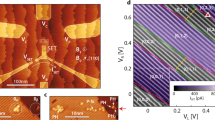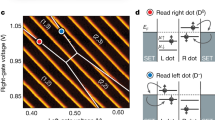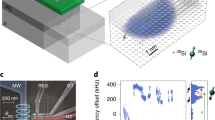Abstract
The electronic and nuclear spin degrees of freedom of donor impurities in silicon form ultra-coherent two-level systems1,2 that are potentially useful for applications in quantum information3 and are intrinsically compatible with industrial semiconductor processing. However, because of their smaller gyromagnetic ratios, nuclear spins are more difficult to manipulate than electron spins and are often considered too slow for quantum information processing. Moreover, although alternating current magnetic fields are the most natural choice to drive spin transitions and implement quantum gates, they are difficult to confine spatially to the level of a single donor, thus requiring alternative approaches. In recent years, schemes for all-electrical control of donor spin qubits have been proposed4,5 but no experimental demonstrations have been reported yet. Here, we demonstrate a scalable all-electric method for controlling neutral 31P and 75As donor nuclear spins in silicon. Using coplanar photonic bandgap resonators, we drive Rabi oscillations on nuclear spins exclusively using electric fields by employing the donor-bound electron as a quantum transducer, much in the spirit of recent works with single-molecule magnets6. The electric field confinement leads to major advantages such as low power requirements, higher qubit densities and faster gate times. Additionally, this approach makes it possible to drive nuclear spin qubits either at their resonance frequency or at its first subharmonic, thus reducing device bandwidth requirements. Double quantum transitions7 can be driven as well, providing easy access to the full computational manifold of our system and making it convenient to implement nuclear spin-based qudits using 75As donors8.
This is a preview of subscription content, access via your institution
Access options
Access Nature and 54 other Nature Portfolio journals
Get Nature+, our best-value online-access subscription
$29.99 / 30 days
cancel any time
Subscribe to this journal
Receive 12 print issues and online access
$259.00 per year
only $21.58 per issue
Buy this article
- Purchase on Springer Link
- Instant access to full article PDF
Prices may be subject to local taxes which are calculated during checkout




Similar content being viewed by others
References
Tyryshkin, A. M. et al. Electron spin coherence exceeding seconds in high-purity silicon. Nat. Mater. 11, 143–147 (2012).
Morton, J. J. et al. Solid-state quantum memory using the 31P nuclear spin. Nature 455, 1085–1088 (2008).
Kane, B. E. A silicon-based nuclear spin quantum computer. Nature 393, 133–137 (1998).
De, A., Pryor, C. E. & Flatté, M. E. Electric-field control of a hydrogenic donor's spin in a semiconductor. Phys. Rev. Lett. 102, 017603 (2009).
Tosi, G. et al. Silicon quantum processor with robust long-distance qubit couplings. Preprint at http://arxiv.org/abs/1509.08538 (2015).
Thiele, S. et al. Electrically driven nuclear spin resonance in single-molecule magnets. Science 344, 1135–1138 (2014).
Yusa, G., Muraki, K., Takashina, K., Hashimoto, K. & Hirayama, Y. Controlled multiple quantum coherences of nuclear spins in a nanometre-scale device. Nature 434, 1001–1005 (2005).
Bartlett, S. D., de Guise, H. & Sanders, B. C. Quantum encodings in spin systems and harmonic oscillators. Phys. Rev. A 65, 052316 (2002).
Davies, E. A new pulse ENDOR technique. Phys. Lett. A 47, 1–2 (1974).
Tyryshkin, A. M., Morton, J. J. L., Ardavan, A. & Lyon, S. A. Davies electron–nuclear double resonance revisited: enhanced sensitivity and nuclear spin relaxation. J. Chem. Phys. 124, 234508 (2006).
Yun, T.-Y. & Chang, K. One-dimensional photonic bandgap resonators and varactor tuned resonators. Microwave Symposium Digest, 1999 IEEE MTT-S International 4, 1629–1632 (1999).
Liu, Y. & Houck, A. A. Quantum electrodynamics near a photonic bandgap. Nat. Phys. 13, 48–52 (2017).
Bronn, N. T. et al. Broadband filters for abatement of spontaneous emission in circuit quantum electrodynamics. Appl. Phys. Lett. 107, 172601 (2015).
Weis, C. D. et al. Electrical activation and electron spin resonance measurements of implanted bismuth in isotopically enriched silicon-28. Appl. Phys. Lett. 100, 172104 (2012).
Ziegler, J. F., Ziegler, M. & Biersack, J. SRIM—the stopping and range of ions in matter (2010). Nuclear Instrum. Methods Phys. Res. B 268, 1818–1823 (2010).
Sigillito, A. J. et al. Fast, low-power manipulation of spin ensembles in superconducting microresonators. Appl. Phys. Lett. 104, 222407 (2014).
Sigillito, A. J., Tyryshkin, A. M. & Lyon, S. A. Anisotropic Stark effect and electric-field noise suppression for phosphorus donor qubits in silicon. Phys. Rev. Lett. 114, 217601 (2015).
Malissa, H., Schuster, D. I., Tyryshkin, A. M., Houck, A. A. & Lyon, S. A. Superconducting coplanar waveguide resonators for low temperature pulsed electron spin resonance spectroscopy. Rev. Sci. Instrum. 84, 025116 (2013).
Wilson, D. K. & Feher, G. Electron spin resonance experiments on donors in silicon. III. Investigation of excited states by the application of uniaxial stress and their importance in relaxation processes. Phys. Rev. 124, 1068–1083 (1961).
Pica, G. et al. Hyperfine Stark effect of shallow donors in silicon. Phys. Rev. B 90, 195204 (2014).
Laird, E. A. et al. A new mechanism of electric dipole spin resonance: hyperfine coupling in quantum dots. Semicond. Sci. Technol. 24, 064004 (2009).
Romhányi, J., Burkard, G. & Pályi, A. Subharmonic transitions and Bloch–Siegert shift in electrically driven spin resonance. Phys. Rev. B 92, 054422 (2015).
Franke, D. P. et al. Interaction of strain and nuclear spins in silicon: quadrupolar effects on ionized donors. Phys. Rev. Lett. 115, 057601 (2015).
Franke, D. P., Pflüger, M. P. D., Mortemousque, P.-A., Itoh, K. M. & Brandt, M. S. Quadrupolar effects on nuclear spins of neutral arsenic donors in silicon. Phys. Rev. B 93, 161303 (2016).
Pla, J. J. et al. Strain-induced nuclear quadrupole splittings in silicon devices. Preprint at http://arxiv.org/abs/1608.07346 (2016).
Sigillito, A. J. et al. Electron spin coherence of shallow donors in natural and isotopically enriched germanium. Phys. Rev. Lett. 115, 247601 (2015).
Sigillito, A. J. et al. Large Stark tuning of donor electron spin qubits in germanium. Phys. Rev. B 94, 125204 (2016).
Pica, G. & Lovett, B. W. Quantum gates with donors in germanium. Phys. Rev. B 94, 205309 (2016).
Eichler, C., Sigillito, A. J., Lyon, S. A. & Petta, J. R. Electron spin resonance at the level of 104 spins using low impedance superconducting resonators. Phys. Rev. Lett. 118, 037701 (2017).
Bienfait, A. et al. Reaching the quantum limit of sensitivity in electron spin resonance. Nat. Nanotech. 11, 253–257 (2016).
Acknowledgements
The authors thank G. Pica, J.J.L. Morton and P. Bertet for insightful discussions. Work at Princeton was supported by the NSF through the Princeton MRSEC (grant no. DMR-01420541) and by the ARO (grant bo. W911NF-13-1-0179). Work at LBNL was performed under the auspices of the US Department of Energy under contract no. DE-AC02-05CH11231.
Author information
Authors and Affiliations
Contributions
A.J.S., A.M.T. and S.A.L. conceived and designed the experiments. A.J.S. and A.A.H. designed the photonic bandgap resonators. T.S. supplied the samples. A.J.S. performed the experiments and modelling. A.J.S., A.M.T. and S.A.L. wrote the paper, with input from all authors.
Corresponding author
Ethics declarations
Competing interests
The authors declare no competing financial interests.
Supplementary information
Supplementary information
Supplementary information (PDF 712 kb)
Rights and permissions
About this article
Cite this article
Sigillito, A., Tyryshkin, A., Schenkel, T. et al. All-electric control of donor nuclear spin qubits in silicon. Nature Nanotech 12, 958–962 (2017). https://doi.org/10.1038/nnano.2017.154
Received:
Accepted:
Published:
Issue Date:
DOI: https://doi.org/10.1038/nnano.2017.154
This article is cited by
-
Anisotropy with respect to the applied magnetic field of spin qubit decoherence times
npj Quantum Information (2022)
-
Room Temperature Electrically Detected Nuclear Spin Coherence of NV Centres in Diamond
Scientific Reports (2020)
-
Coherent electrical control of a single high-spin nucleus in silicon
Nature (2020)
-
Electrically controlled nuclear polarization of individual atoms
Nature Nanotechnology (2018)
-
Electrical control of nuclear spins
Nature Nanotechnology (2017)



